Radiocrafts Experience in the Solar Industry
Our familiarity with the solar industry extends over several years, as we’ve been serving customers within this sector for a long time. These customers sought our services proactively, without significant outreach on our part. Although we offer radio solutions across diverse segments, a noticeable trend emerged a few years ago: an increasing number of customers approaching us for solutions related to solar applications. About a year ago, we recognized the value in enhancing our understanding of the solar industry and delving deeper into this specific segment.
Consequently, we made the decision to actively engage with the solar industry. Notably, we participated in Intersolar events in both 2022 and 2023 as part of the Norwegian pavilion. This platform provided us with the invaluable opportunity to interact with both our existing customers and new prospects in the solar sector. As a result of our commitment to understanding the solar industry, many of the insights and information we are presenting today we have learnt by digging into the Solar industry and trying to get a better understanding of this.
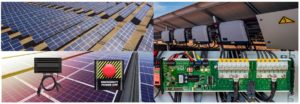
Therefore, in this blog post we will discuss, the solar industry in great detail starting with what the solar industry actually entails, industry trends, the varying devices needed to power a solar installation and the role each of these devices play in the system, cabling solutions versus wireless, the wireless solutions suitable for the solar industry, and finally, Radiocrafts’ RIIM mesh solution which supports several market-leading features optimized for the solar industry.
So what is the Solar Industry?
The Solar industry encompasses three distinct segments.
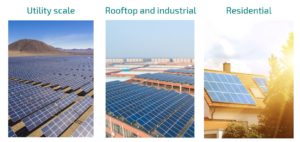
Firstly, there are the utility scale installations, characterized by their expansive size. These installations consist of vast arrays of solar panels numbering in the thousands, along with solar trackers that enable precise sun tracking throughout the day for optimal angles. These installations are typically situated in open fields and desert landscapes.
The second segment comprises of medium-sized installations that are quite large but still not as substantial as the installations out in the desert. These systems are commonly situated on rooftops and are referred to as the rooftop and industrial segment.
Finally, we have the residential segment. This typically includes a single household or a cluster of households that have solar panels installed on their roofs. Some of these setups might also include energy storage and electric vehicle charging systems as integrated components.
It is interesting to note some differences between these systems which are influenced by grid codes. The grid codes define how these installations interface with the public electricity grid. The larger the installations are, the stricter the requirements, defining exactly how these installations should feed energy into the grid and how they should adjust their output so you don’t overload the grid. This distinction holds significant importance when contrasting these various systems.
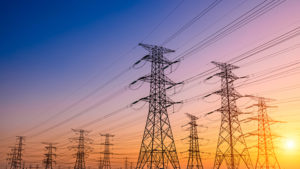
It is also worth mentioning that some EU regulations now mandate the inclusion of solar installations in certain new constructions. This mandate is anticipated to significantly amplify the number of installations, particularly in the rooftop and residential categories.
Is there a trend in the Solar Industry?
Is there a trend in the Solar industry? Are we moving towards the residential and smaller installations or are we seeing growth in all mentioned segments?
Indeed, growth is evident across all the segments mentioned.
While there exist slight variations in requirements and the system configurations to meet radio requirements, overall, we see an equally good uptake across each of these segments.
What type of devices are in a Solar installation and what are their jobs in the system?
There are many devices which are commonly found in solar installations with variations in component presence across segments.
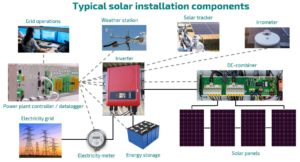
The foundational element is the solar panels, often interconnected in a series, channeling their DC voltage through a device known as a DC combiner. A DC Combiner takes a series of solar panels. When you connect these solar panels in a series you get a higher DC voltage that is then fed into the inverter. The DC combiner is then able to monitor these solar panels. A DC combiner is particularly used in large utility scale installations to detect, for instance, the physical degradation that can happen with the solar panels over time.
In specific scenarios, solar panels might directly supply DC voltage to the inverter, allowing room for architectural diversity.
The inverter then takes the DC voltage and generates AC main voltage which is fed into the electricity grid via an electricity meter.
A pivotal device present across these architectures is the power plant controller or data logger. For large-scale installations with many inverters and DC combiners, this device will typically be called a power plant controller. The power plant controller is used to send control commands to the inverters so that the inverters can adjust their output according to the needs of the electricity grid.
For the smaller sized installations, the device is often called a data logger focused on logging energy data generated by the inverter and identifying inverter malfunctions.
In large-scale installations there is typically a connection or an API between the grid operator and the power plant controller. This allows the operator of the public utility grid to send commands to the power plant controller so that they can adjust the output of the inverters to meet the needs of the grid. For example, if you have too much renewable energy generated, then the grid operator may send a command to the power plant controller for it to reduce the output of the inverters. This communication will typically have some latency requirements. This should happen rather quickly for the inverters to adapt so we don’t get into a critical situation where you burn up the grid because you have too much electricity flooding into the grid.
On large-scale installations you also find several of other devices such as weather stations, solar trackers that position the angle of the solar panels correctly towards the sun, irrometers that will measure the amount of incoming sunlight, and devices that measure the angle of the trackers to make sure they actually move accordingly.
Energy storage also plays a role, with battery banks integrated across installation sizes.

For residential and rooftop setups, EV charging stations can be incorporated to support electric vehicle charging. An essential part of the residential setup is also the energy manager which is responsible for orchestrating consumption according to local production as well as pricing on energy from the grid. It tries to run local loads at a time when energy is cheapest. This will typically correspond to the time of the day where the solar panels generate the most energy.
In essence, a solar installation constitutes an intricate IoT system with a lot of communication going on.
Cable Solution versus Wireless?
The case with large-scale installations today is that they use a lot of cabling encompassing extensive fiber optic loops and kilometers of various cables. These cables include electrical cables, RS485 cables, and fiber optic cables that are dug into the ground. However, wireless technology is also becoming more popular. For all these installations there are many benefits of going wireless.

Challenges arise when utilizing wired connections, such as susceptibility to lightning strikes and ground loops when cables are buried underground. If a cable interlinking multiple devices falters, it results in communication loss within that entire segment of the solar setup. Moreover, the labor-intensive process of laying cables and ensuring precise installation incurs considerable costs.
Given these challenges, there is a requirement and growing interest for wireless because it reduces installation costs significantly. The conventional approach of wiring a complete system can take several days whereas the wireless alternative offers flexibility, ease of installation, and cost savings. These factors collectively drive the adoption of wireless solutions, especially as the demand grows to deploy these systems seamlessly and efficiently.
Which Wireless Technologies Are Suitable For Solar Installations?
There are many wireless technologies, 3 different solar segments as we have mentioned previously, and considerable equipment in each segment which gives rise to varied requirements.
One of the key requirements is the requirement for long range. Using the residential segment for context, if the system is based on micro inverters connected directly to the solar panels, there is a need for reaching the inverters from the controller located indoors. This creates a challenge as the concrete walls reduce the range significantly. Similarly, non-residential rooftop installations, often you have a controller located 2 or 3 floors down in a building which needs to communicate with inverters on the roof. In the case of large-scale utility installations where you have kilometres of solar panels, you need long range to reach every single tracker and DC combiner.
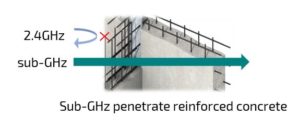
This range concern leads us to Sub-GHz radio communication offering superior range to the 2.4 GHz technologies. Moreover, scenarios where solar panels are distributed across several rooftops in a single network emphasizes the need for a multi-hop solution, aka, a mesh solution, to ensure scalability.
The combination of Sub-GHz and mesh seems to be a very good solution for all three types of Solar installations.
Another advantage of Sub-GHz is illustrated in the image below. As you can see a power plant controller communicates with a rooftop inverter, which subsequently acts as a router, propagating the communication to/from other inverters. In such setups, the capability for extended range remains a critical factor.
Another requirement which kind of contradicts range is latency because with latency requirements, you must consider carefully what type of equipment you are communicating with.
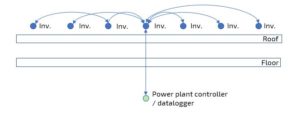
If you are monitoring a weather station you don’t have to read it every 1 millisecond because the weather doesn’t change that quickly. You can instead measure the wind every minute or so for example. On the other hand, scenarios demanding quick adjustments like reducing voltage influx into the grid demand near real-time communication when dealing with numerous inverters.
Radiocrafts RIIM Mesh Technology for Solar Installations
Radiocrafts offers a Sub-GHz mesh solution, RIIM, which is highly suitable for all 3 solar installation segments mentioned previously.
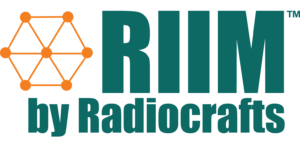
Using RIIM, users can do a multitude of adaptations for the different solar installation systems, for example, some want quick network joining times while others want low latency or to have many devices in a single network. All these requirements can be tuned and prioritized in the network settings. We also do quite a lot of work on customer specific development, for example, if a customer wants additional features than what is provided in the standard product. In other words, RIIM is customizable by the user but we can also add more customization on top of that if the customer requirements are beyond what the standard product can achieve today.
In addition to range and latency, there is also the requirement for reliability. We are replacing cables here and cables normally work fine. They have wear-and-tear which can cause cable breakage, sand build-up in the connector, and more, so cables have their limitations. However, with wireless communication you can lose a packet. RIIM addresses this challenge by leveraging cutting-edge technologies such as “Time-Slotted Channel Hopping (TSCH)”. TSCH is a protocol which enables you to send a data packet in different frequencies and at different time slots in a synchronized schedule. It is world renowned as a frequency hopping system which works exceptionally well for getting high reliability on a system.
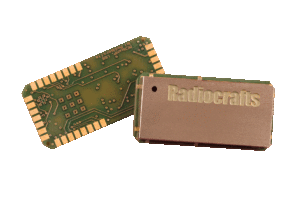
Data throughput also influences solar system designs significantly. How much data is each device generating? A weather station does not create that much data while a solar inverter can create a lot of data. It is a system design choice. How much processing can be done locally at the inverter or solar panels? How can the data be filtered or compressed? But at the end of the day, you end up with a certain amount of data which needs to be transferred from one device to another. If you only transfer alarms for example, your network will have a requirement for low latency but it will generate very little traffic. But if, for example, you have hundreds of bites of data from each device every second you can get congestion in the system because you have too much traffic.
One of the key elements in the RIIM network was designed to answer this latency issue for high throughput networking. For context, in EU specifically, there is a challenge with duty cycle limitations. When you start to transfer a lot of data, you will get the challenge that in EU, with the RED directive, you are only allowed to send data 1% of the time. That creates big problems for high throughput systems. For example, with LoRaWAN, if you are sending a data packet at a long range you have to wait 10 minutes between each packet because otherwise you violate the 1% duty cycle rule. Since RIIM leverages frequency hopping, you can use multiple radio channels. RIIM also uses the Adaptive Frequency Agility feature, which works by scanning all the channels, finding the noisiest ones, and removing them from the hopping list. Furthermore, when you send a RIIM data packet, it uses Listen-Before-Talk (LBT). Combining AFA and LBT, you get something called Polite Spectrum Access which according to the RED Directive and the EU standards for wireless communication, allows you to send up to 37% of the time. This combination enables high throughput networking with minimal traffic congestion and packet loss.

To add onto that, RIIM’s robustness extends to managing noise interference such as from other protocols like a Sigfox or LoRa base station which operate in a single channel. This means that if we see there is a lot of noise in that channel, you can choose to not use that channel with RIIM.
Similarly, the RIIM architecture further caters to scenarios involving multiple parallel RIIM networks in utility scale installations. For example, a large-scale installation with up to 10,000 solar panels will not be connected to a single network. You will typically have many different networks in parallel which are in close proximity to each other. If all the networks were operating on the same channel they would interfere a lot with each other. We have heard of customers using single channel systems who have had huge problems with interference when scaling up their networks. Therefore, because RIIM uses frequency hopping and is synchronized differently from network to network, the networks will automatically avoid each other. RIIM’s frequency hopping and synchronization mechanisms inherently prevent interference between networks, resolving scalability concerns without customer intervention.
What To Take Away From This?
The need for renewable energies is growing rapidly as we try to fight the effects of global warming. The Solar industry plays a massive role in this search for more sustainable ways of living and generating power. Every part of society can play a role in moving the Solar movement forwards including in both large-scale deployments of hundreds of thousands of solar panels and inverters in the deserts all the way down to each individual household in our local neighbourhoods. Each of these Solar segments use a varied combination of equipment and devices required to create an efficient and long-lasting Solar installation, for example, power plant controllers, inverters, energy meters, EV charging stations, energy storages and more. Furthermore, the Solar industry is slowly starting to adopt wireless solutions as an alternative to wired solutions because wired solutions can get quite expensive with maintenance, installation, and labour costs. One example of a wireless solution which is optimal for the Solar segment is Radiocrafts’ Sub-GHz mesh technology, RIIM, which provides long range due to the multi-hop mesh architecture, low latency, high reliability with channel hopping features, high data throughput with Adaptive Frequency Agility and Listen-Before-Talk features, and excellent performance including in noisy environments.

